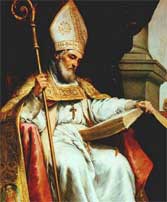| Profile | Major Works | Resources |
Isidore of Seville, c.560-636.

Isidore of Seville was the brother and successor of Leander of Seville, who converted the Visigothic rulers of Spain from Arian to Catholic Christianity in 589. Isidore became Bishop of Seville in 600 and helped guide the fledgling Spanish Church in the decades of upheaval that followed. Isidore promoted a hard line on latent Arians, insisting on the insertion of the controversial filioque clause in the Nicene creed to that effect. Isidore also notoriously advocated a hard line against the Jews, which the Visigoths, up to that point, had left relatively unmolested.
Isidore of Seville's principal work is undoubtedly his Etymologies, a massive encyclopedia, attempting to encompass all Classical Greek and Roman knowledge available before the Dark Ages buried it completely. Organized in 'etymological' fashion (by definitions), many of which are quite conjectural and often absurd, it nonetheless open the way to Isidore's summaries of the Classical wisdom, either directly from the works of Classical authors he has available - Plato, Aristotle, Ptolemy, etc - or as transmitted the summaries of Boethius, Cassiodorus and other Dark Age writers. This encyclopaedic work will remain one of the few reference for Classical learning for centuries to come.
Among the more amusing definitions, in his entries on money (Etymologies xvi: 18), Isidore suggests that the term moneta (coinage) comes from monet (third person of "monere", "to warn") "because it warns lest any fraud should enter into its composition or weight", that nomisma (a coin) comes from nomen (meaning "name") "because it bears the imprint of the name and likeness of a prince" and that nummus (coin pieces) are so called because Numa Pompilus, an early King of Rome, "was the first among the Latins to mark them with the imprint of his image and name."
Isidore founded his own school at Seville and was the leading figure at the Fourth Council of Toledo, promulgating the establishment of seminaries in all the cathedrals of Spain, under the special responsibility of the bishops, and the promotion of the study of Greek, Hebrew, the seven liberal arts, law and medicine.
Isidore is also commonly credited for introduced the famous flat T-O 'disc-shaped' earth hypothesis that will be adhered to in nearly all Christian mappa mundi until the 16th C.
|
Major Works of St. Isidore of Seville
|
|
Resources on Isidore of Seville
|
All rights reserved, Gonšalo L. Fonseca
